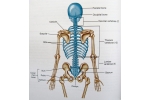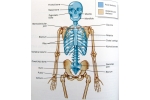Introduction
Human beings originated, according to modern anthropology, somewhere
in Africa. But, being hunter gatherers, humans migrated north
and first of all settled around the Mediterranean. Some tribes started
populating Spain, France, etc. while other tribes wandered to the
Middle East. As hunter-gatherers, humans lived on the food they
found in their environment. This went on for hundreds of thousands
of years. Then came the neolithic revolution: humans started to produce
food. In the Middle East, agriculture had been developed - and
as we are told through the anthropologists - by women. Becoming
agriculturists meant to become, at least, semi-settlers. The invention of
farming had a great influence on the position of women in the tribal
society. They embodied the mystery of life, since they gave birth, thus
allowing the tribe not only to survive, but to grow, and when women
started producing more food through farming, their status still rose.
Women became the object of a cult and the innumerable statuettes
representing women found in Europe and everywhere proves this.
Society became matriarchal and the Great Mother-Goddess is humanity's
first religion.
But some other tribes, too, made their neolithic revolution; i.e.,
started to produce their own food. Being hunters, they went northward
to follow the herds, and invented cattle-raising, which made
plenty of food available. Being hunters, they had to devise arms not
only to kill the game (horses, stags, wild boars), but dangerous animals
as well, like bears, and eventually human beings; the hunters
became warriors. For raising cattle they had to move in order to find
more pastureland. From the cold, high north, they had to migrate
southward, and met other cattle-raising tribes. To steal other tribe's
cattle was fun and profit, but meant war. They killed the enemy warriors,
enslaving the women, whom they shared as parts of the loot.
Soon the cattle-raisers found out that by having fifty ewes but no ram,
nothing happened, but as soon as they added even one ram, soon they
could see results. This fact gave the male priority over the female.
Society became centered on the warrior and the male: the organization
became patriarchal and pyramidal. Their gods were deified heroes.
Those tribal men were strong, brave, but reckless warriors, with the
chief of the tribe at their head. Today our social organizations are the
very copy of this plan.
Meanwhile, the farming tribes slowly migrated peacefully from
their Mediterranean and Middle-East homes to the Indus Valley.
Migrating, they mixed with local tribes and people, and in India, they
mixed with aboriginals who already had started creating cities and
ports. Mixing the migrating farming tribes with the aboriginal ones
made the Dravidian race, who developed around 3000 B.C., the Indus
Valley civilization, which became an empire with hundreds of cities,
some having a population of thirty to forty thousand souls. They
became highly civilized. Their cities were very comfortable. Practically
each house had its own well and bathroom. Unlike, for instance, the
ancient Egyptians, they did not raise huge buildings, like temples,
palaces, or pyramids, but had a clever sewage system. Remember,
18th-century Paris had no sewage system. Their cities were plagued
by the floods of the Indus, and each time they rebuilt the houses on
the old foundations. They built the harbor of Lothal which could handle
up to fifty ships. They were bold sailors, and, for instance, traded
with Ancient Egypt, Syria, Sumer, and many other countries.
On the other hand, the barbaric patriarchal tribes, the Aryans,
invaded India from the north, in order to find pastures for their huge
herds. They started to conquer the Indus Empire, which was vast—
1,500 miles square. It took a couple of centuries to conquer the Indus
Valley people. When the conquest was over, the Aryans imposed their
patriarchal organization. The population became divided into four
classes: first, the Brahmins or priests, followed by the Kshattrias or
warrior-class, their chiefs became kings (Rajas or Maharajas), the third
class were the Vaishyas, or dealers, landlords, usurers. The fourth
were the defeated Dravidians, the Shudras, i.e., slaves whose only
right was to serve faithfully the three upper classes. This division into
classes is rigid and strictly racial. No one can enter a class except by
being born into it. The unsubmitted tribes, living in the jungles,
forests, and other out of the way places were outlawed by the Aryan
society, and became the Untouchables, who did not even have the status
of true human beings.
The invaders destroyed the Indus Valley civilization and after
many dark centuries, a new brahmanical civilization arose, and the
Vedic religion, with its innumerable sacrifices to the gods, became the
religion of the conquerors. The Shudras, or slaves, were strictly forbidden
to listen even to Rig Vedic hymns. In fact, the Rig Veda is the
mythologized narrative of the cruel war of attrition fought by the
invading Aryans against the Dravidians. In the Rig Veda, the Aryan
warriors were the gods, their Dravidian opponents, the demons. The
slaves were allowed to have their own old religion and modern
Hinduism originates from the blending of the two cults.
Many centuries later, the Aryans succeeded in totally wiping out
the Indus civilization; not only eradicating the cities, but making them
literally disappear under the surface of the earth, and any recollection
of this civilization sank into oblivion in the memory of their descendants,
the slaves. The Aryans, for centuries, made the entire world
believe that when their ancestors, the "good" Aryans, invaded India,
around 1500 B.C., they found the country only populated with savage
aboriginals, whom they civilized. In 1925 however, this legend came
to an end, when the British wanted to build a railroad to Lahore. The
two English civil engineers in charge of this task were in trouble
because in the plains they could not find stones to ballast the railroad.
An Indian foreman told them, "You want ballast? No problem: under
the mound you see up there are bricks by the millions." It was true!
Amidst the bricks they found small carved objects with an unknown
script, the famous Indus seals. The engineers had the intuition that
they had, by pure chance, discovered the very old artifacts from an
unknown and forgotten civilization. Archeologists came and dug out
the cities of Mohenjo-Daro and Harappa, and still later, many more
forgotten cities.
Knowing this, one understands that modern India is not a true
monolithic society, but a conflictual one, tense with the relentless
opposition between the matrifocal tantrics together with the descendants
of the previous civilization, against the foreign, Vedic, brahmanical,
patriarchal society, imposed on the Indian people by the power of
war. Tantra originates from the pre-Aryan era, and is set against this
patriarchal Aryan, oppressive system. The invasion of India by the
barbaric Aryan tribes was a blast, but the counter-blast is to come
when the shudras, becoming aware of their power, will no longer tolerate
this. And this counter-blast could change the face of the world.
Bearing the above mentioned facts in mind will make some statements
included in this book readily intelligible, and explain why the brahmanical
society is male-oriented and tantra the exact opposite!
With this brief history in mind, modern readers will have a new
understanding of the concepts of tantra. This book takes the old theories
and brings them into the modern world.



